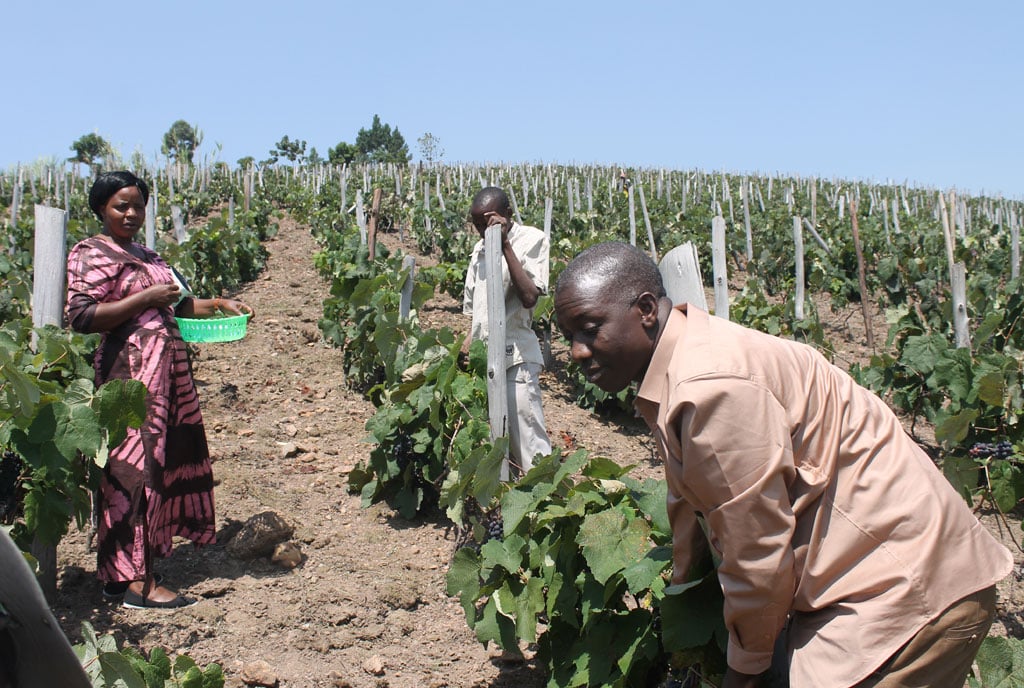Prime
Here is how to grow grapes

Ham Ahimbisibwe shows some of the ready for harvest grapes at his farm in Itaaba,Nyakayojo, Mbarara town. PHOTO/NMG
What you need to know:
- Grapes must be harvested when all the berries have developed the unique colour and desired TSS of the cultivar.
- TSS is a measure of the density (mass/volume) of all the soluble solids in grape berry juice.
- Grapes are harvested by repeated pickings since the bunches do not ripen at the same time.
Grape cultivation is emerging one of the most lucrative and profitable farming in the western district such as Kabale, Kisoro, Ntugamo, Rukungiri and Mbarara.
Grape is cultivated under a variety of soil and climatic conditions in three distinct agro-climatic zones. Grapes are grown in both temperate and tropical climate.
In a tropical climate, vines remain evergreen. Grapes perform well where there is no or little rain at the ripening time.
Land preparation
Grapes are found cultivated on a variety of soil types. The best soil types for grapes are known to be well-drained loam to sandy loam with good organic matter.
Poorly drained, alkaline soils should be avoided. Grapes are grown well on soils having less than pH 8.7 and EC up to 1.5 mmhos/cm, calcium carbonate up to 10 percent and lime concentration up to 20 percent.
The land is tilled and laid into plots of 120 m x 180 m separated by 3m wide roads. Land within a plot is levelled perfectly to have a gradient of less than 1 percent in any directional manner to make sure the uniform distribution of water through the emitters of drip irrigation systems.
Trenches of 75 cm width, 75 cm depth and 118 m length in a north-south direction with a gap of 3 m between trenches are opened with heavy machinery. They are closed with topsoil, up to a height of 45 cm after 15 days exposure to the sun.
The remaining gap is filled with a mixture of soil, cattle manure, single superphosphate, sulphate of potash and micro-nutrients.
Usually, 50 kilogrammes of cattle manure, 2.5 kilogrammes of superphosphate, 0.5 kilogrammes of sulphate of potash and 50 g each of ZnSO4 and FeSO4 are added to the soil for every running meter length of the trench.
Best planting season
The best season for planting the rooted cuttings of cultivated varieties in the main field is September-October whereas for rootstocks it is February-March.
Pruning
Pruning should be done in January every year when the vines are still dormant. As a farmer you must keep only fruiting canes with the recommended number of buds per cane depending upon the cultivar.
The rest of the shoots are pruned to one or two buds. These according to agronomy are called renewal spurs. In districts such as Mbarara, Kabale, Kisoro, Rukungiri, Bushenyi and Ntungamo, staggered pruning is done to get fruit all along the year.
ALSO READ: Agronomy tips for planting guava
The common variety grown in western Uganda is the Pinot Noir. Nicholas Musinguzi who has been growing the grapes since 2015 says pruning is done at any time of the year after the crop has been established in the garden.
“The number of nodes retained on the cane varies with the variety and cane thickness,” says Musinguzi.
Manure and fertiliser application
Musinguzi says any farmer interested in grape farming must be ready to apply fertilisers especially manure which supports organic farming.
To the recently planted vines, the farmer advises application of 20 grammes of urea which must be repeated in the space of 30 days.
Weeding
Vines are planted closely and normally on bower system, hence due to shade, weeds could make little growth.
But in vineyards trained on Kniffin and head system, the weeds get ample irrigation, nutrition and light to flourish.
ALSO READ: Grapes grower’s pursuit of wine making
Therefore, it is very necessary to control weeds. Weeds between the rows of vines are removed both manually and mechanically.
Intercropping
Farmers are advised against intercropping. “Intercropping must not be practiced in the vineyards,” says Musinguzi.
Harvesting
Grapes must be harvested when all the berries have developed the unique colour and desired TSS of the cultivar. TSS is a measure of the density (mass/volume) of all the soluble solids in grape berry juice.
Grapes are harvested by repeated pickings since the bunches do not ripen at the same time. Taste is the most valuable indicator of the ripeness of the bunch. The berries at the shoulder ripen first followed by the centre and tip then tip of the clusters.
Land preparation
Grapes are found cultivated on a variety of soil types. The best soil types for grapes are known to be well-drained loam to sandy loam with good organic matter.
Poorly drained, alkaline soils should be avoided. Grapes are grown well on soils having less than pH 8.7 and EC up to 1.5 mmhos/cm, calcium carbonate up to 10 percent and lime concentration up to 20 percent.




